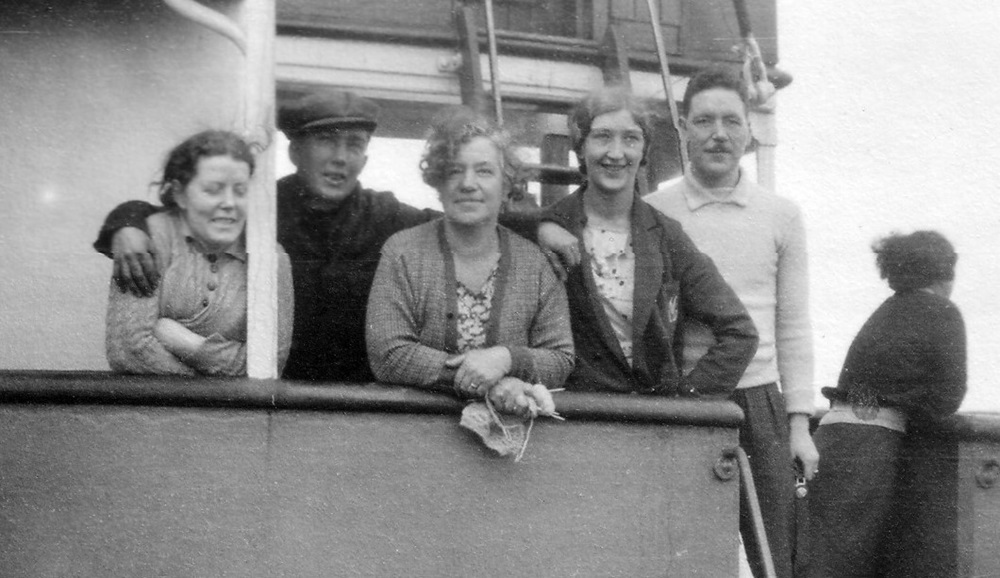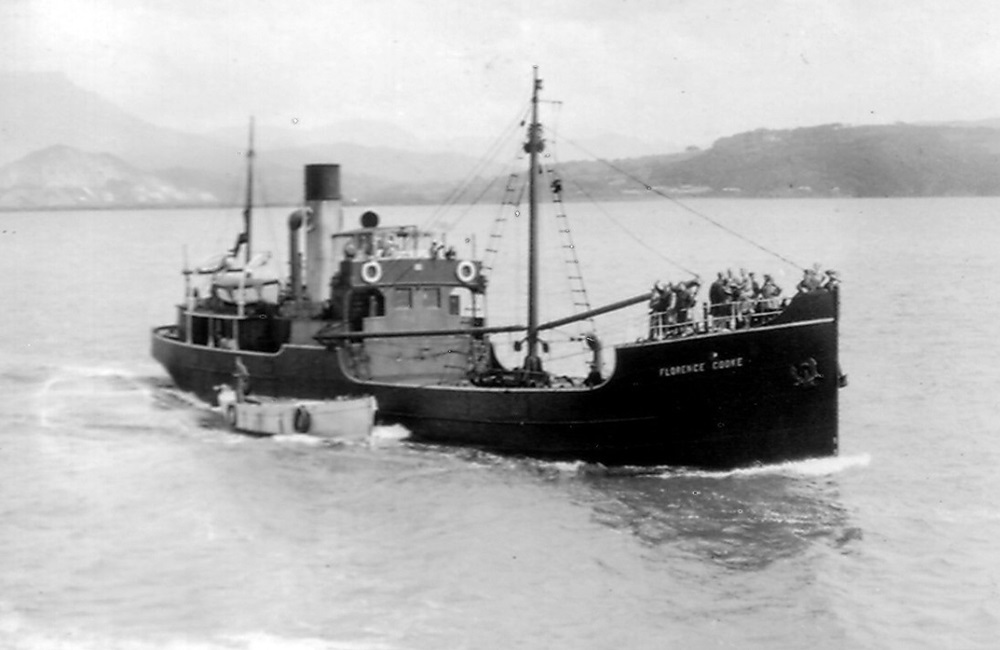Museum appeals for answers about history of wartime ship

Dale Spridgeon, Local Democracy Reporter
A museum is searching for the “missing history” of a ship, which may have played a “secret role” in the Second World War.
An appeal has been put out asking for help to “fill in the gaps” over what happened to the SS Florence Cooke – or ‘the Florrie’, as she was affectionately known, between May 1944 and October 1944.
The ship carried explosives and munitions and was one of the few powered ships associated with the port of Porthmadog. She is believed to have taken part in various special Wartime missions.
D-Day
Florrie even played a part in D-Day, although according to museum volunteer, Captain Dave Creamer: “Not much is known about her role.”

People aboard the ‘Florrie’ (Image Courtesy Of The Porthmadog Maritime Museum)Captain Creamer, from Penrhyndeudraeth, has been researching the vessel. He is also Chairman of the North Wales branch of the Merchant Navy Association.
His investigations came about amid a recent appeal to find North Wales Merchant Navy veterans who took part in Operation Neptune – also known as the D-Day or the Normandy Landings.
The branch, based in Llandudno, is hoping to invite Merchant navy veterans, who took part in D-Day, or their families, to a special service at Llandudno War Memorial on Sunday, September 1.
Whilst researching North Wales’ ships and crew, Captain Creamer said he had hit “a stumbling block” while looking into the history of the Florrie.
It does not seem to have been anywhere between May and October 1944.
Captain Creamer speculates that the details of Florrie’s whereabouts may have been classified at the time but is appealing for any information people might have to fill in these gaps.
This period also covers D-Day which took place on June 8, 1944.
He is now appealing to anyone who knows anything, or for the crew who may have served aboard the ship, or anyone who had family aboard may have memories of the Florrie.
It is not known if the records from that period are classified, possibly relating to the ship’s work during the Second World War, or if they are just missing.
Florrie at war
According to Captain Creamer, there are newspaper clippings linking the ship to the D-Day Landings, in the museum. Operation Neptune, as it was codenamed, was the largest seaborne invasion in history.
It started with the liberation of France, and the rest of Western Europe, and laid the foundations for the Allied victory on the Western Front. Captain Creamer said, “Lots of people in the Porthmadog area and beyond, still have fond memories of the Florrie, she was a very well-known ship in her heyday.”
“But it would appear that there is very little information if any at all in local records about her from May 1944 up to October 1944, which is a puzzle.
“This maybe because personnel were totally committed to the events occurring or it may be because such information has been deemed ‘not for public eyes.’
“I know the Florrie was deployed in the ‘Special Services’ group for D-Day but, interestingly, there is no mention of her in any of the books about the ships involved in D-Day.”

Florrie’s known history
The ship belonged to Cookes Explosives Ltd, based in the northeast of England, but which developed a depot at Penrhyndeudraeth.
The history of the Florrie, as far as it is known is laid out in the museum history of the Florrie, it tells how the ship was built at Hepples yard in South Shields to the order of the Cookes Explosives LTD.
“Their offices and distribution depot, from where explosives were sent to the surrounding coal mines, was at Maiden Law, Co Durham.
“The increased demand for explosives during the First World War forced the company to look for a quiet site to build a new factory, and Penrhyndeudraeth, near Porthmadog, was chosen. The factory is now closed.
“She started trading in 1923. Her cargoes were raw material to Porthmadog for the manufacture of the explosives, then the finished product was carried to the Tyne.
“She had a hinged mast and funnel which could be lowered to allow passage up the river to Newburn. The explosives were then taken by lorry to Cookes’ depot.
“Explosives and detonators were delivered to other ports in Cornwall and Scotland. The return cargo was usually household coal although she did sometimes wander further afield in the coastal trade.
“There was some passenger accommodation intended for company personnel though the Captain could allow others to travel onboard.
“She was requisitioned by the Admiralty in 1939 and used as an ammunition ship, first at Milford Haven and later at Scapa Flow.
“She took part in the Normandy landings and was released from the Navy in 1945. “The Florrie continued on the explosives run until 1959 when it was decided that road transport was more efficient. It added:
“She was sold to a Dutch shipbreaker though there is a tantalising story of her being seen, minus machinery and accommodation, in use as a dumb barge, trading on the inland waterways.”
Captain Creamer has invited any of the crew or their families to their commemoration service in September, adding: “It is very strange, we’d love to find out more, if anyone can help fill in the gaps or have memories of the ship, please get in touch!”
Support our Nation today
For the price of a cup of coffee a month you can help us create an independent, not-for-profit, national news service for the people of Wales, by the people of Wales.





Maybe she was the seaborne version of the ‘Red Ball Express’ as the Battle for Walcheren began on November 1st resulting in the opening of the Scheldt and, at last a port…
If you could supply a list of books and other sources already consulted it would help…
‘The Ballad of the Florence Cooke’ YouTube Scottish Maritime Museum…
It was a hard fought battle of RN landing craft and the 79th verses an array of artillery to get the troops ashore…
November 1st, 80 years, it might get a mention…
Captain Creamer needs to look at Cambrian Coasters by Roy Fenton (World Ship Society, 1989) where he will find that in April 1944 the Florence Cooke was sent from Scapa Flow, where she had been serving as a munitions carrier, to Portsmouth to take part in the invasion fleet. There, her main duty was to carry special fifteen inch shells used to bombard German defensive positions on the French coast, shells which were fired by the ‘monitors’ HMS Erebus and HMS Roberts. She was released from naval requisition in February 1945 and would return to serving Cooke’s again before the… Read more »
Those same guns were in action off Walcheren, hence we can surmise that she followed the fleet to the Scheldt that autumn…A place to look would be the port books of smaller harbours between the two…
Warspite was with them and using her time-line it is possible to follow them, bombardment by bombardment, via Brest and Le Harve before opening up Antwerp…